A Valentine’s Day surprise happened to me yesterday: something exciting was called to my attention:
Callsheet has won an Editor’s Choice award in the App Store!!
I couldn’t can’t believe my eyes.
Look at it!
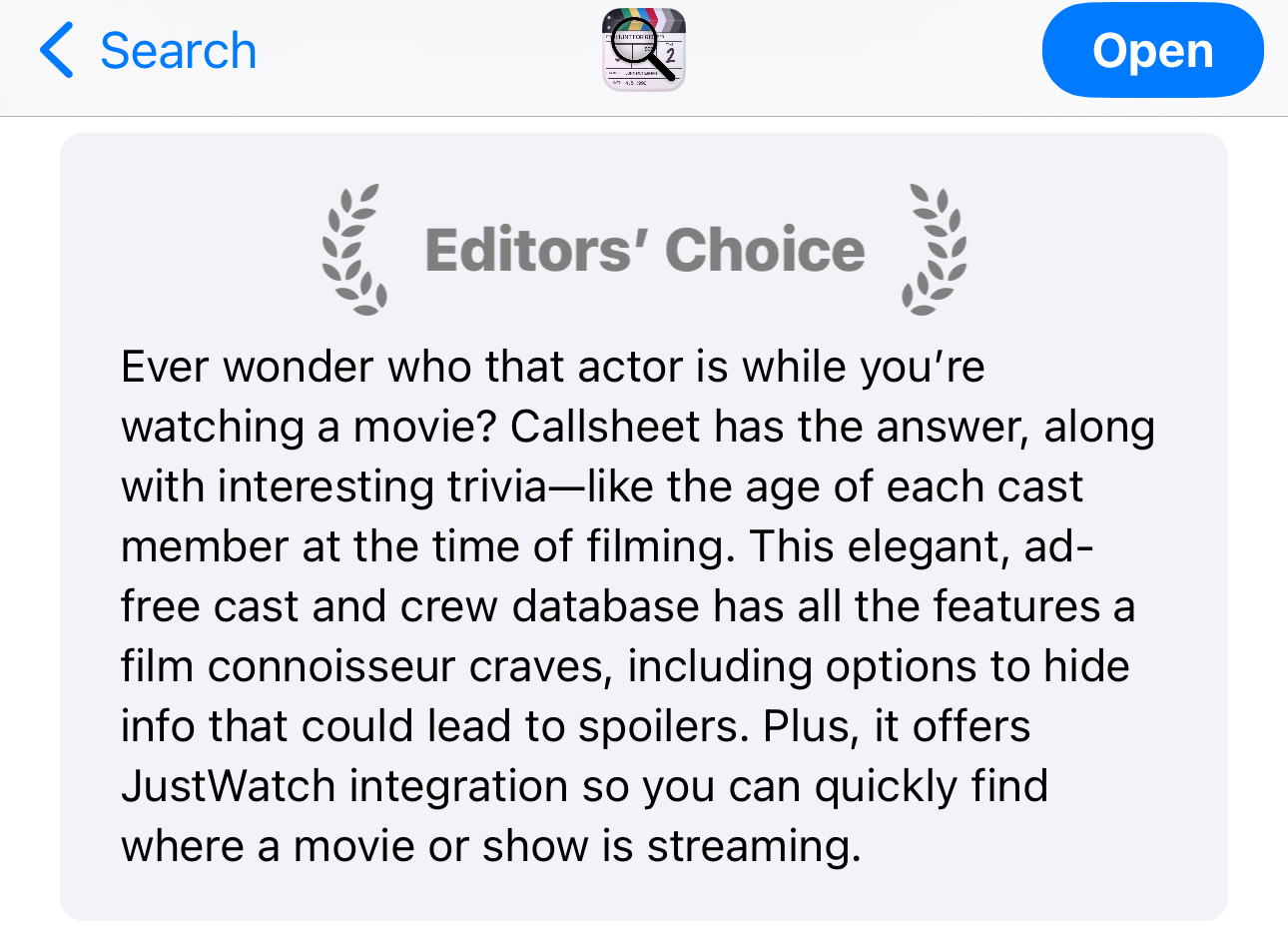
I’m not sure exactly when this landed, but I’m absolutely overjoyed about it.
As an added bonus, it shows up in search results too:

I’m not sure who at Apple made this selection, but know I’m forever thankful to you. 💙
Thanks to this, and the Upgradie, Callsheet is now a multi-award winning app. That’s pretty great. 😊
This is my desk, today. Captured in situ, which is to say, messy as it always is:

Upon it, from left-to-right:
- A LG UltraFine 5K that was graciously given to me
This monitor lives on my desk in the winter and is mostly used on the back porch in summer. - An Apple Studio Display
- A LG UltraFine 5K that I bought secondhand from a podcaster friend
This is, by my count, 44,236,800 pixels of real estate[1]. I could absolutely get my work done in a single 5K display. I’ve found over the last couple years that I prefer to use 2× 5K. And if I have another just sitting around during the winter, why not add a third? It’s a bit overkill, but, #yolo.
Having all this space lets me spread out while I do my work. I organize things by display, and generally, it’s something like this:
- Left: Things I don’t look at often, like mail/RSS/mastodon, as well as general-purpose browsing
- Center: Xcode & iOS Simulator
- Right: Git, documentation, Safari for research purposes. I also use a second Space (virtual desktop) here which runs Slack and Messages in split-screen.
I love this setup, until I leave it. Much like independent workers who are “unemployable” after enjoying just a few months of indie life[2], I feel hamstrung when I work elsewhere. Which I like to do at least once a week. I have stopgap measures, but they’re not great.
As I write this, we are a week-and-a-day away from consumers getting their hands on Apple Vision Pro. This ludicrously expensive device seems to be much like the Apple Watch — it has an ostensible purpose, but nobody really knows what consumers will actually do with it. For the Apple Watch, the purpose was fitness (or notification triage). For Apple Vision Pro, it’s entertainment, at least to start.
In thinking about where an Apple Vision Pro will fit in my life, I kept coming up short. I suspect it will be the best device in the house upon which I could watch a movie — quite a bit better than even my LG C9 and my beloved Sonos home theatre. However, watching something on Apple Vision Pro is an inherently solitary endeavor. My family can’t watch the movie I’m watching when it’s being blasted directly into my eyeballs.
I can absolutely imagine Apple Vision Pro being a phenomenal device when used on planes or trains. For better and for worse, I just don’t have the occasion to do so particularly frequently. I have made one plane journey since 2019, and one train journey.[3]
Standalone, I’m not entirely convinced Apple Vision Pro is for me. While I’m sure I’ll enjoy the rare occasions I get to use it without snubbing those around me, I don’t see those situations as being frequent enough to justify the considerable price tag.
Over the last week or so, as I debate how silly it was for me to preorder an Apple Vision Pro, I’ve found myself growing more and more excited about receiving it. This is unusual for me with Apple products, where I usually have an immediate crash of enthusiasm after a purchase. Not quite buyer’s remorse, as much as “oh, well, that’s done”. With Apple Vision Pro, I find my enthusiasm and excitement is 📈. Why?
It’s because my perspective has changed.
I remain mostly ho-hum about Apple Vision Pro as an entertainment device. Not because I doubt its capabilities — far from it. More because I just don’t have the occasion for a lot of solo media consumption today, so why would tomorrow be any different? It’s not you, it’s me.
However, with each passing day, I get incredibly excited about the prospect of Apple Vision Pro as a tool for getting work done. Though I’m very happy with my desk setup — lack of tidiness notwithstanding — it would be amazing to be able to bring that setup elsewhere.
With Apple Vision Pro, I reckon I will be able to.
Apple Vision Pro may be the best Mac accessory Apple has ever created.
Yesterday was an odd day, in which I spent time working at two different local libraries. While I was there, I realized that I am a week and change too early. If I had my Apple Vision Pro with me, I could have the workspace of my dreams, all with only my MacBook Pro and Apple Vision Pro.
Apple Vision Pro supports… uh… sucking-your-Mac-into-the-virtual-world mode. A 4K version of your Mac’s screen appears in the virtual space, but you can still interact with your Mac using its own keyboard and mouse.
That would allow me to build something like this extremely poor rendering shows:
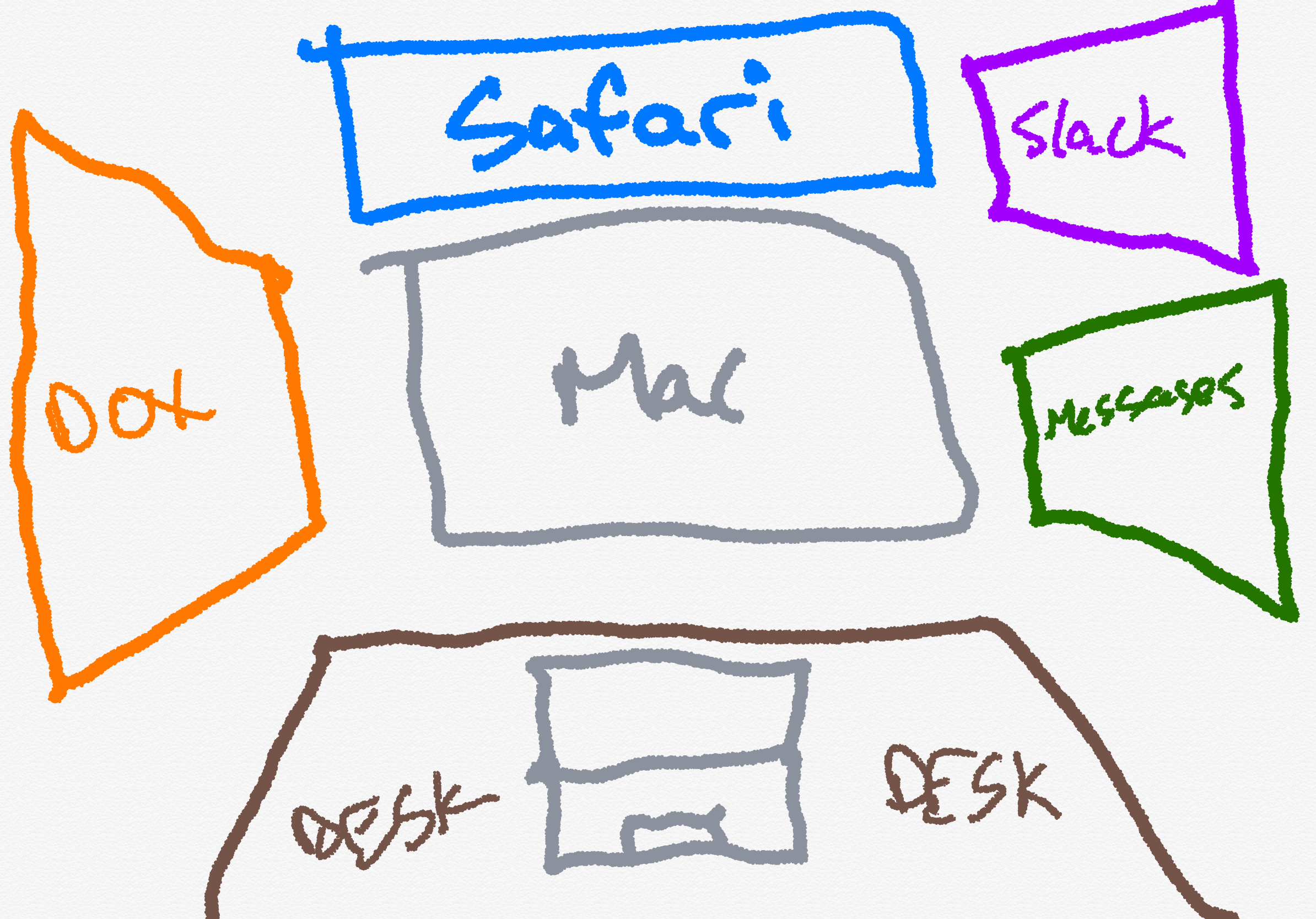
In this, I envision Slack and Messages to be the visionOS-native versions. I’m intermingling native visionOS apps with my Mac; the latter’s “monitor” is simply one window in the virtual space. That window, showing my Mac’s screen, can be surrounded by several visionOS-native apps as I see fit. The marriage of macOS and visionOS.
You know what’s better than 44 million pixels of real estate? ∞ pixels of real estate.
Now, imagine I could take things further. What if visionOS also supports Universal Control, between macOS and visionOS? Imagine I get a message in Slack or Messages, then I simply cast my gaze over to the visionOS-native app, and then start typing a response on my Mac’s keyboard.
🤯
This could genuinely level-up my ability to get my work done when away from the house.[4]
I remain blasé about Apple Vision Pro, standalone entertainment device. With each passing day I get more and more amped for Apple Vision Pro, my MacBook Pro’s greatest accessory.
The future isn’t here yet, but if Apple has done what I expect, it arrives on the second of February.
And I couldn’t be more excited.
Roughly 24 million pixels more than you XDR folks. So there. ↩
I try very hard not to be unemployable, as you never know what the future holds. Here’s hoping I either never need to find out, or I can ease into the real world with grace if the time comes. ↩
Have y’all heard about trains? They rule. We Americans should look into these things more. ↩
Assuming I can get past the social stigma of being that guy. It didn’t take long with AirPods; I presume it’ll happen eventually with Apple Vision Pro too. ↩
We’re not even three weeks into the new year, but I’ve spent a fair bit of time
procrastinating from working on Apple Vision Pro stuff working on updates for
Callsheet. Today’s, in particular, is worth calling attention to.
In today’s update to Callsheet — version 2024.4 — I have fixed something that has driven users absolutely mad. I kicked the can down the road repeatedly, in part because I was trying to over-complicate the solution. I also did because this particular thing didn’t bother me that much
…until it did.
Erin and I were watching Oppenheimer, and I was curious who played the role of Albert Einstein. Oppenheimer has a ton of actors in it, and it took an annoying amount of scrolling to find the actor in question. I knew that my users were right: there needed to be some sort of affordance for searching within these lists.
Now, there is. Simply swipe down to expose a standard, system search field:
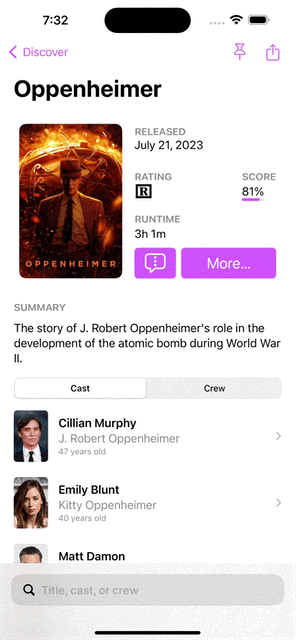
Hopefully this will resolve most people’s largest issue — including me. 😊 Note to self: listen to your users.
In addition to a plethora of bug fixes, I also added another minor feature: the ability to grab a Callsheet link (rather than web link) via the sharrow. If you happen to know that the person you’d like to send a link to is also a Callsheet user, you can now send them a link that iOS/iPadOS will open directly in Callsheet.
When you tap on a sharrow, you’ll now get a menu, where you can choose which to share:
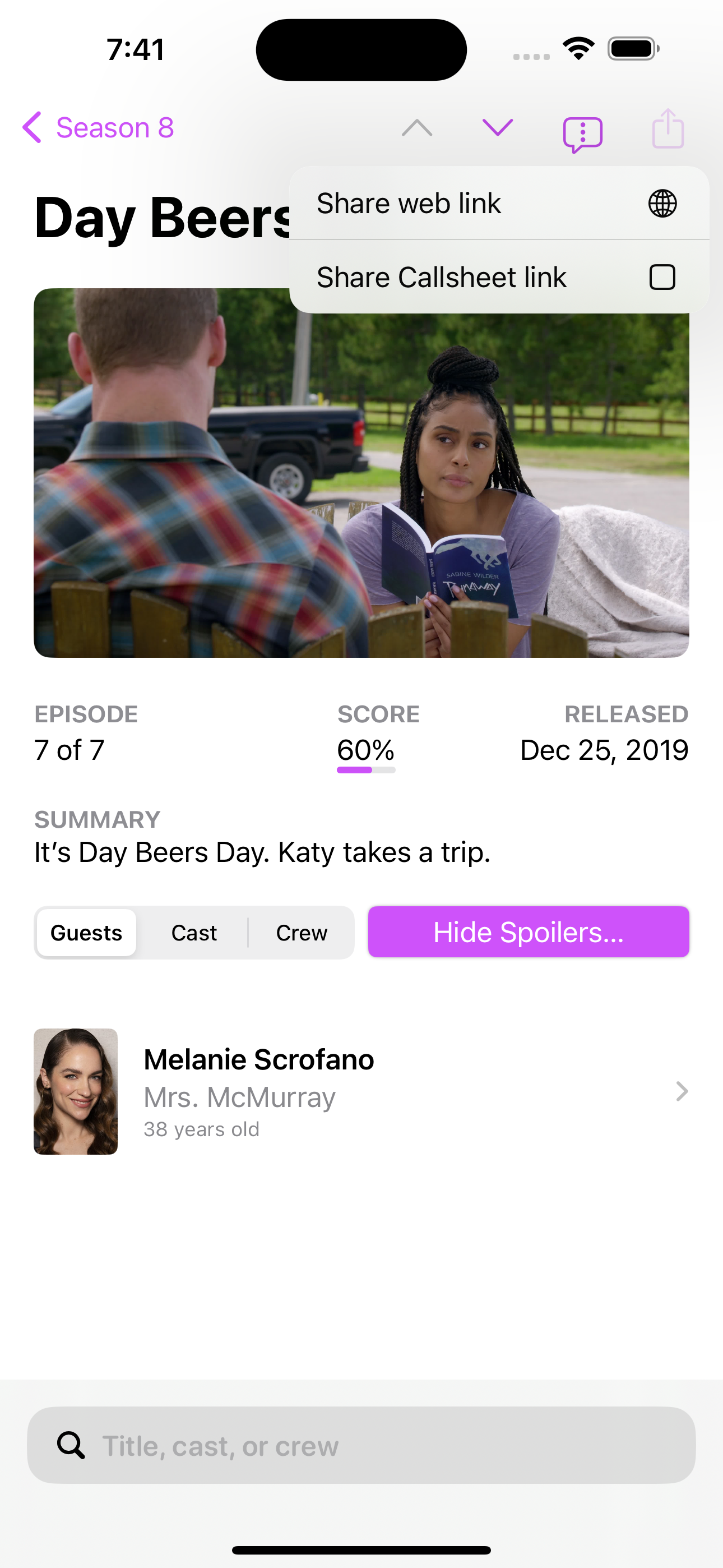
Wherever possible, deep links are supported. The above would have shared this link.
In addition to the above, there’s also been a ton of bug fixes, which are detailed in the app’s release notes on the App Store, because I’m not a jerk.
Version 2024.4 is rolling out slowly now, but if you’re impatient, open up
the App Store and search for Callsheet. That should offer you the option
to Update and thus jump the queue.
Eking in just before the new year, I joined my friend John Gruber on his seminal podcast, The Talk Show. While we set out to cover Apple’s 2023 and do a year-in-review, we got quite far off the rails… quite often.
Sorry, not sorry. 😏
When John and I started recording on Friday night, I don’t think either of us set out to record a roughly 200-minute podcast, but sometimes, it just gets good to you, and you just don’t want to stop.
I had a ton of fun bouncing stuff off of John, and vice versa. This episode is the perfect way to close the book on 2023, and open 2024.
If you are very lucky, you can point to a moment when you feel like you can say to yourself, “I’ve arrived”.
Yesterday, I arrived.
I was absolutely beaming, with my family around me, as we all listened to this week’s Upgrade, which included the tenth annual Upgradies. Thanks to Myke and Jason, I can now honestly say
Callsheet is an award winning iOS app!!
Callsheet has won the award for Best Newcomer iOS App!
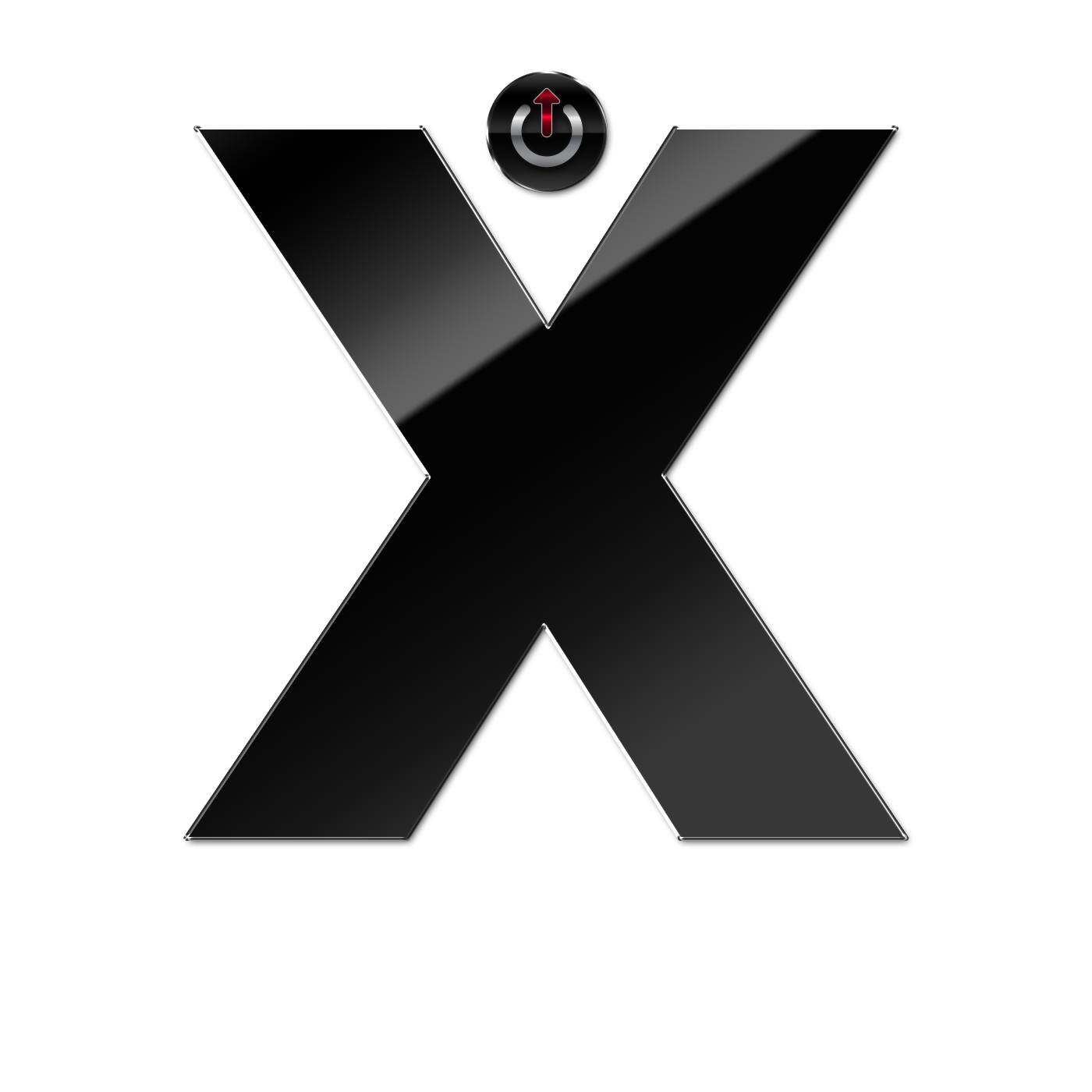
This is an immense honor, and has affected me quite a lot, in the best possible way. With my prior apps, I was/am proud of them, but they are a very different caliber of app. Callsheet is more impressive, and it feels amazing to have my efforts (and those that assisted me!) publicly recognized.
Maybe I really am a professional app developer after all, huh? 😏
My tremendous thanks to Jason, Myke, and all the Upgradians who voted for me. It really, truly, means the world to me. 💙
A couple weeks ago, I joined my friends Rosemary Orchard and David Sparks on their show Automators, which is all about the many different ways you can automate/improve your life.
My forgetfulness to write this post should not be indicative of a lack of enthusiasm. 🫣😬 I really did have a lot of fun!
On our episode, we discussed my history with home automation, dating all the way back to my dad’s X10 setup back when I was in high school. We discussed some weird issues I’ve been having with some of my automations, as well as ways to improve the ones that are already working properly.
Both David and Rosemary are a veritable wealth of information, and I think a lot of the things we discussed are inspirational — if not applicable — to many.
A few weeks ago I joined Leo Dion to talk about all things Callsheet. The episode is a really great overview of my thought processes in creating Callsheet, some of the problems I had along the way, and also some of the wins. Callsheet is a labor of love, and I think (and hope!) that really comes across, especially in this interview with Leo.
We also reflect upon our mutual time as C# developers, which is a time I miss more than I often admit to myself.
Leo’s interview is available as a podcast or as a video. No matter how you prefer it, the interview runs a little shy of 90 minutes. There’s also a transcript if that’s more your speed.
About a month ago, I bought myself a portable monitor. At least once a week, I like to work from somewhere other than my house. Usually that’s one of our amazing local libraries, but sometimes that’s the café area in a local grocer.
I had been using Sidecar for this, with my 11" iPad Pro, but I find Sidecar to be mostly reliable and mostly without latency. But it never seems to be completely reliable nor completely without latency. Even if I plug in a USB-3 cable.
I wanted something small, light, thin, and bus-powered, so I could have a single USB-C connection between my computer and the monitor — nothing else. For bonus points, a monitor that was at or near “Retina”, so it doesn’t look like pixellated garbage next to my incredible MacBook Pro screen.
I landed on this Arzopa 13", 2K mointor. I’ve been using it on-and-off for the last month, and I like it. As I write this, it’s currently on sale at Amazon for $116, down from the $136 normal price, and cheaper than the $130 I paid for it.
Pros
- Extremely thin and light
- Comes with a cover that can be used as a stand
- Bus-powered
- Looks retina to my [admittedly bad] eyes
- When the settings are tweaked just right, can get reasonably bright
- Can also operate as a portable TV, with the provided Mini-HDMI ↔ HDMI cable
Cons
- The cover/stand is extremely flimsy, and depending on what surface it’s on, can sometimes slide about. It’s enough, but just barely
- The monitor defaulted to HDR mode, which sounds great, but ended up being way too dim. Once I turned off HDR and cranked up the brightness, it was much better
- The speaker, naturally, is trash
- It will never be as bright as the MacBook Pro’s screen; it’s only 300 nits, but indoors, that has been plenty
Ultimately, you get what you pay for, but $116 for a pretty-nice portable monitor for use when I’m out and about is perfect.
Today, I joined my pals Kelly, Lex, and Mikah on Clockwise.
On today’s episode, we discussed our must-have streaming service, our favorite not-home and not-work place to get work done, our webcam setups, and our most-used iPhone accessories.
Clockwise is always a fun time, and always fast. I particularly enjoyed this episode — despite Dan’s absence — and always enjoy chatting with these three. :)
Callsheet’s release has been a whirlwind. I’m completely overjoyed by the response. I am incredibly thankful to anyone who has tried Callsheet, purchased it, or told their friends about it. Y’all are the best. 💙
Yesterday I pushed a new version to the App Store, and it is rolling out slowly over the next week or so. I wanted to highlight some of the changes I think are pretty fun.
Short-short Version
- TV spoiler settings are now honored when viewing a person’s filmography
- When viewing a person, their age is shown on their filmography
- Mid- and post-credit scenes are now shown for movies
- Now shows what you’re actively playing in Channels and, experimentally, Plex
Honoring TV Spoiler Settings in Filmographies
Probably the most often requested feature right now is something that I’ve been planning to do for a while. However, it was — at least at first glance — far more complicated than you’d expect.
From the start, Callsheet would let you optionally hide spoilers for
individual TV shows — things like character names, the number of
episodes they’re in, episode titles, episode thumbnails, etc. In Callsheet
2023.3, I added the ability to set a global default for these same settings.
In Callsheet 2023.4, those settings are now honored when viewing a person’s
filmography. There is also a button to toggle between hiding and showing the
spoilers. Naturally, it defaults to hiding.
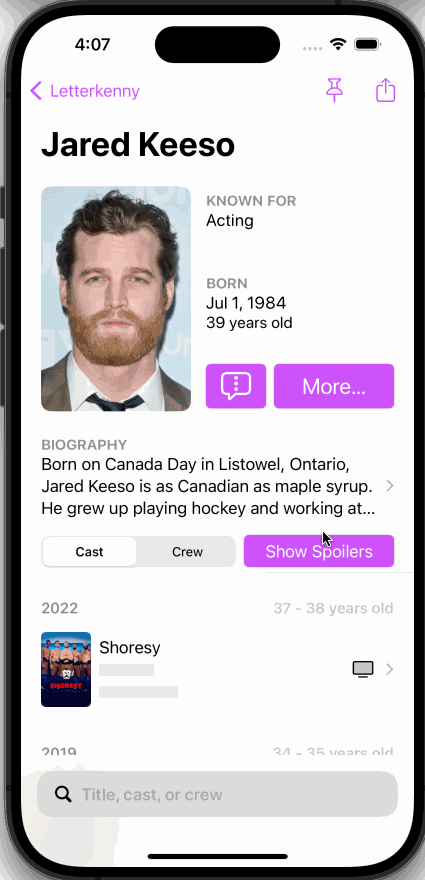
People’s Ages
When looking at an actor or crew’s filmography, I often want to know how old they were when they worked on a film or TV show. Before, this was some reasonably easy mental arithmetic: the person’s birth year is prominently displayed at the top of their screen on the app:
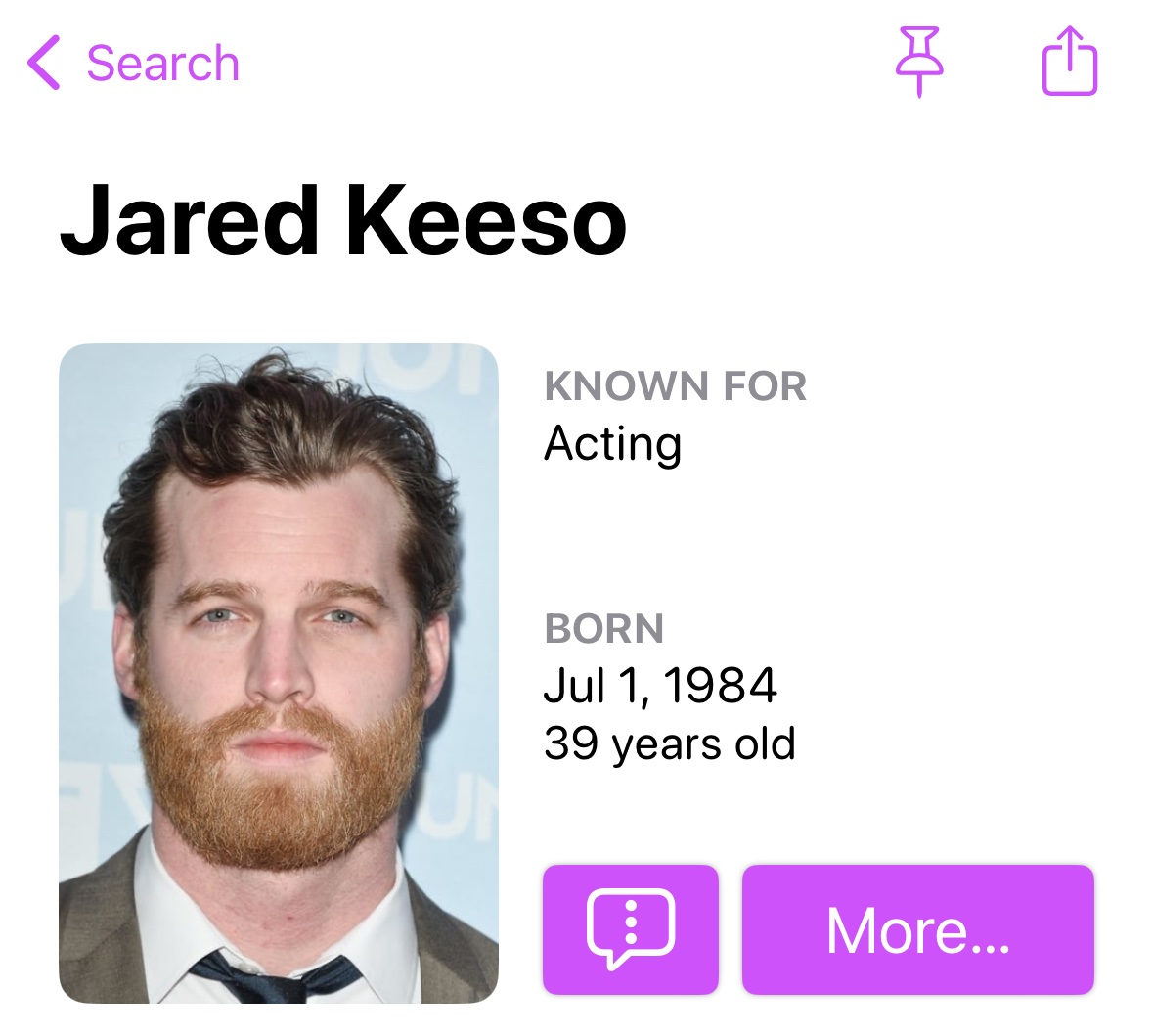
However, our devices are, at their core, arithmetic machines. Why not make them do this math, so I don’t have to? So, for people, you can see their ages in the year header:
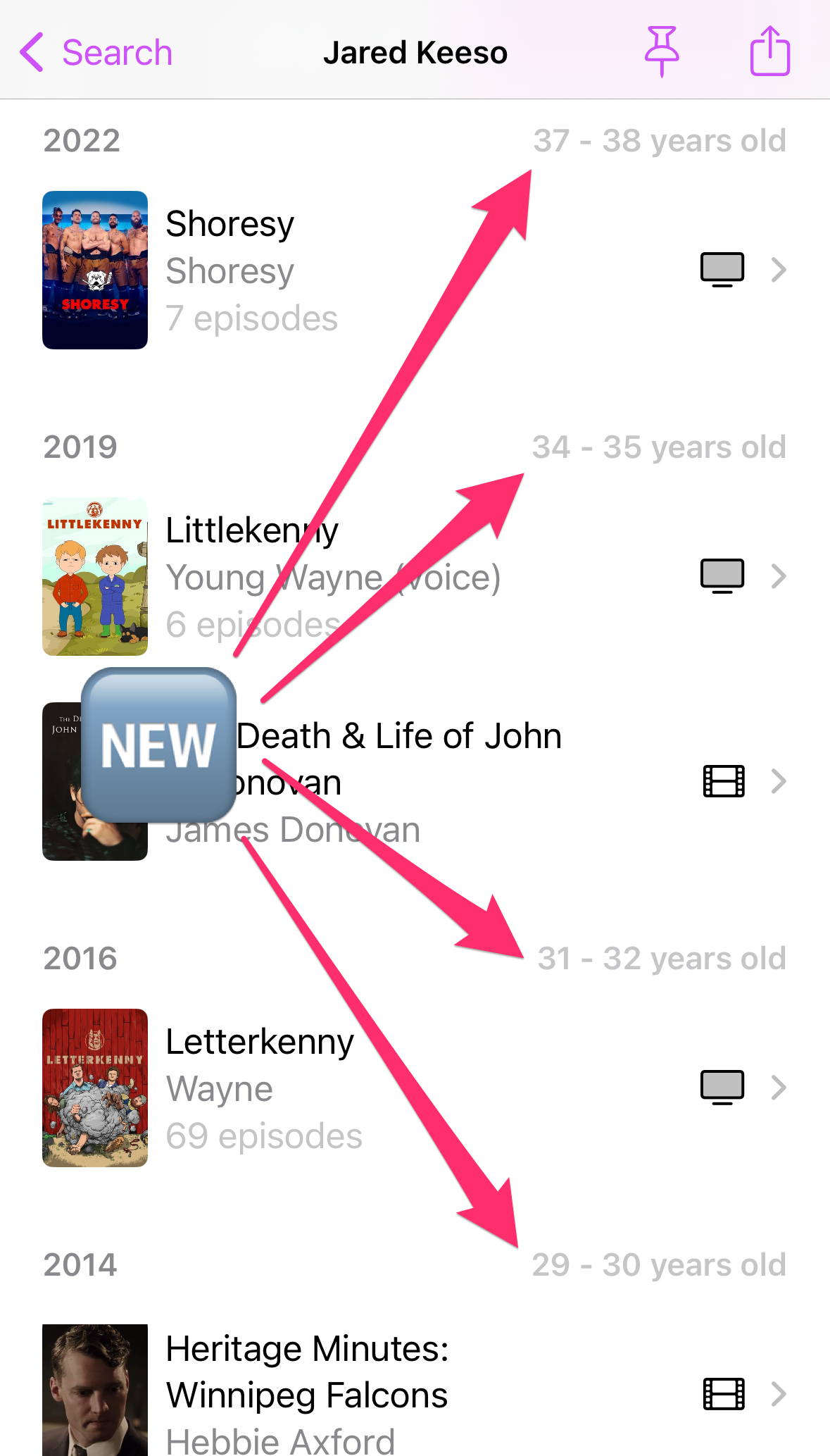
I’m noodling on the best way to represent this information on cast/crew lists for movies and TV shows. 🤔
Mid- and Post-Credits Scenes
Something else I’ve been asked for a lot is the ability to know if a movie — particularly one currently in theatres — has a bonus scene during or after the credits. I didn’t think The Movie Database had this information, but I was wrong. As it turns out, there is a de facto standard for this!
Next, I turned to my friend Ben McCarthy, the author of the excellent Obscura — and the creative force behind a lot of the Callsheet UI. Ben and I went back-and-forth on some SF Symbols-style icons to represent mid-credits and post-credits scenes. You can see them both here. I’m quite pleased with what they came up with. 😎

Integrations
One of my tenets when designing Callsheet was to meet users where they are. This is not a particular revelation, but it is a nice “north star” to guide my decisions and priorities. This is evidenced in simple ways, like tapping on the runtime for a movie to see when it would end, if you start it right now:
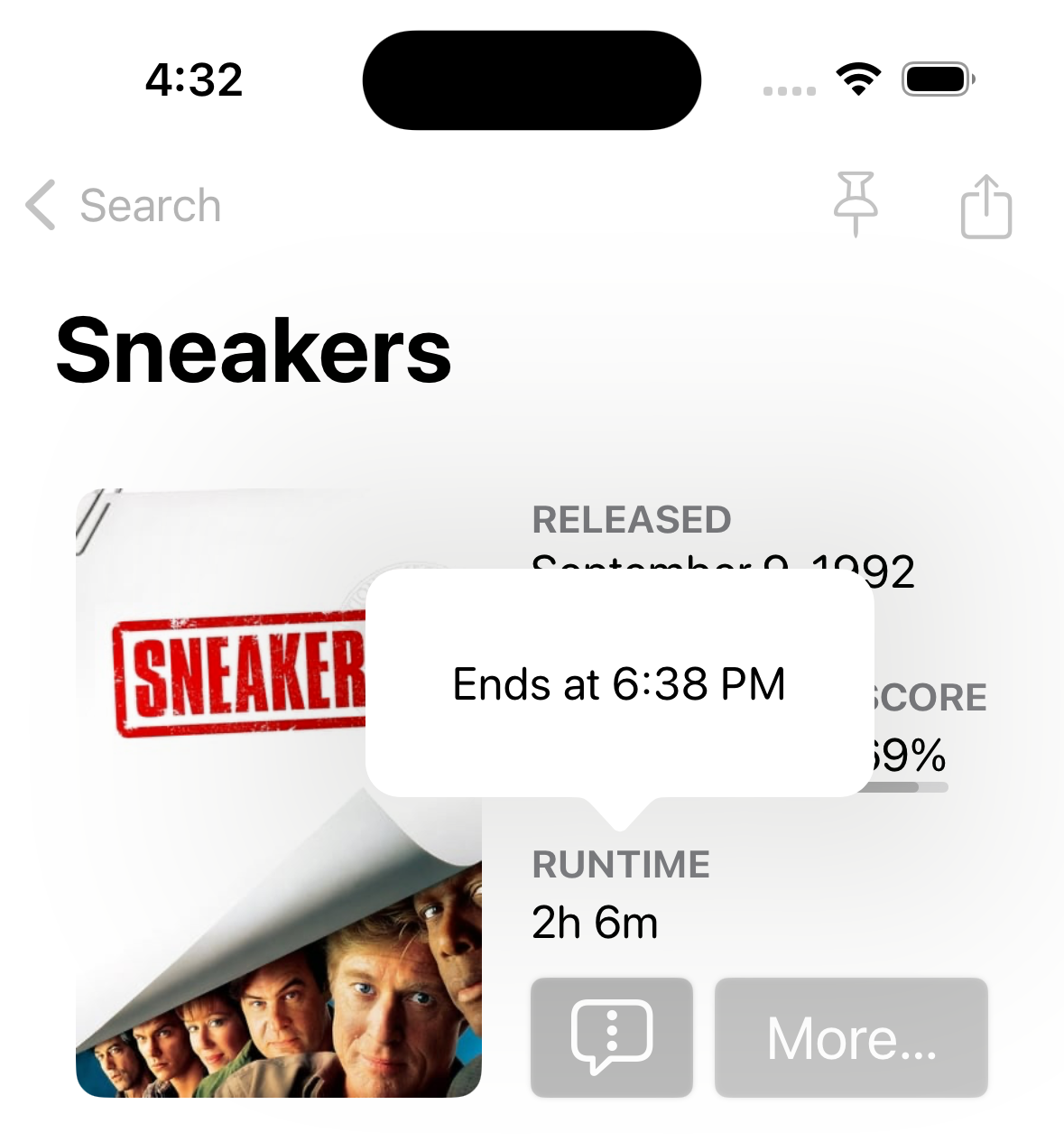
The most obvious way to meet a user where they are is to offer to show them information about the thing they’re currently watching. Unfortunately, Apple doesn’t offer any sort of API for this on the Apple TV. There are allegedly ways to get that information anyway, but it’s extremely convoluted, and prone to break at any time.
Naturally, Callsheet is an app written by me… for me. And for me, the two primary
ways I consume content are Plex and Channels. Callsheet 2023.4
includes Channels integration, as well as an experimental Plex integration.
Both of these integrations are opt-in. In order to enable them, you must go into the in-app settings, and turn on integrations. Both the Channels and Plex integrations work by polling, which means your device will ping away at the network asking “Is anyone here? Are you playing anything?” over and over again. That’s not a bad thing, but it’s not the sort of thing I want your average user to be opted into without their knowledge.

Channels
When everything is turned on, you should see something like this when Channels is playing on a local Apple TV:

Channels uses Bonjour under the hood, which is — naturally — extremely well-supported in the Apple ecosystem. In my experience, the integration with Channels is pretty robust and reliable.
However, Channels doesn’t always provide The Movie Database ID to me — in fact, generally speaking, it doesn’t. This means tapping on an item will usually perform a search, rather than jumping you directly to the show in question. When Channels does provide Callsheet the TMDB ID, you’ll jump directly to the media in question.
Plex
⚠️ The Plex integration should be considered experimental at this time. ⚠️
If you squint, Plex uses a similar scheme to Bonjour in order to discover players on the same network. However, Plex is old enough that it actually predates Bonjour. As such, the implementation is… rickety. Plex’s implementation works for Plex, but it was never really designed for use by other software. Like Callsheet.
That said, it… kinda works? When it does, like the Channels integration, it’s pretty damned magical:

Many thanks to my pals Alex and Hugo; without their combined efforts, there is literally zero chance this would have shipped.
Unfortunately, there aren’t really any levers that I’m aware of that I can pull in order to improve Plex integration. It seems to depend on the “weather” in your local network. So, uh, no promises. 🫣